Star Wars, Nazis, and the Politics of Nonconformity in American Pop Culture
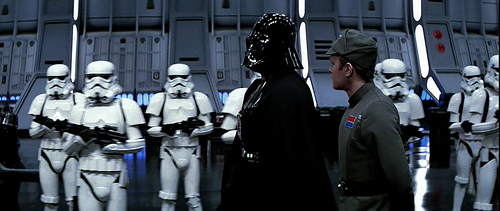
Force Awakens Spoilers Ahead!
Darth Vader is #3 on the AFI (American Film Institute) list of top film villains right after Hannibal Lecter and Norman Bates. What is it about the fictional masked figure which strikes fear and awe into the hearts of fans for generations? Is it the haunting breathing? The force choking grip or the fact that the audience doesn’t see his face for most of his tenure as Star Wars villain? It is most likely a combination of all of these plus the fact that he represents an evil Empire which is not only ruthless, but encompasses a deeply seeded American fear: conformity, the death of the individual.
The minions of the Empire wear uniforms; in the case of the Stormtroopers and Darth Vader, faces are not seen. The individual is erased as the Stromtroopers stand in perfect formations to the sound of marching music, reminiscent of the Third Reich.
Now, in this other well crafted article, the Star Wars universe of Episodes IV, V, and VI is likened to Vietnam era America. In this world, the Empire represents America, and the fears that Americans had of becoming the villains that they feared. However, the Second World War was the largest and most traumatic event of the 20th Century for much of the world including America. Even in the 21st Century Americans still react strongly to information or themes regarding this topic. This was true even in the 1970s when George Lucas first made his films, and Lucas uses WWII aesthetics to communicate his negative thoughts on the direction of his contemporary America.
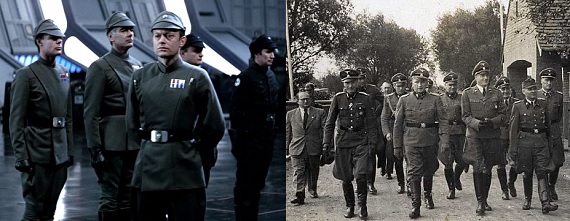
Star Wars is not the only film that does this. The echoes of WWII are present in many aspects of American popular culture either explicitly or non-explicitly because of the way in which the lines of good and evil were very clearly defined during that time. WWII was so monumental that it redefined what it meant to be “American” and fighting extremism became a part of the new American identity while the Nazis became the ultimate bad guy.
Thus, the purpose of this article is not to argue that Star Wars is “about” WWII, but to define core American values, the way in which WWII re-defined them, and the way in which pieces of popular culture like Star Wars use the lessons, themes, aesthetics, and/or figures from WWII to make contemporary statements on the dangers of conformity. This will provide better context for Star Wars episodes IV, V, and VI, as well as the new Force Awakens, which uses these themes as well.
American Values
One might ask “where exactly in American history does ‘nonconformity’ enter the list of core American values?” Nonconformity, defined by Mirriam-Webster as “failure or refusal to conform to a prevailing rule or practice” is inherently connected to the idea of independence and practicing nonconformity is a way of enacting independence and individualism.
It might not be surprising to the reader that many core American values can be traced to America’s founding. After all, Americans venerate the words “All men are created equal” from the Declaration of Independence, and hold “life, liberty, and the pursuit of happiness” as dogma. These principles which Americans hold near and dear, and have been used to justify every civil rights movement, have also trickled down into everything from government policy to cultural mannerisms which foreigners might find arrogant.
For example, the American belief in equality leads many members of this culture to be very casual, even with those in a position of authority. Americans call their presidents “Mr. President” instead of “Your Excellency,” for example, and can even be on a first name basis with bosses. These practices came from an early need to distance America from the formal culture of the European “old world” which was rooted in Medieval and ancient hierarchies such as feudalism or Catholicism. An emphasis on “liberty” creates the value for free thought, free speech, and many other freedoms listed in the Bill of Rights.
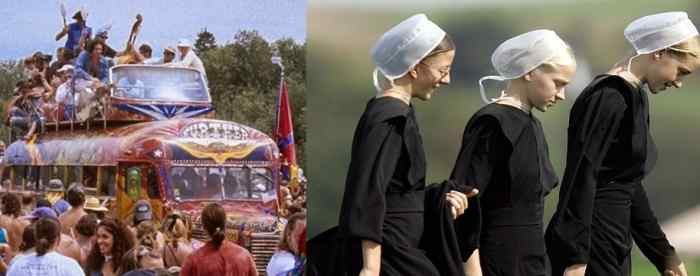
Nonconformity is an American value embraced by both sides of the political and/or cultural spectrum. From a more social conservative/religious point of view, nonconformity has Biblical origins. The phrase comes from Romans 12:2 which says, “And be not conformed to this world: but be ye transformed by the renewing of your mind, that ye may prove what is that good, and acceptable, and perfect, will of God.” In other words, this world is seen as corrupted and the faithful must cast off their connection to the main tides of this world. This idea was applied to the Protestant Reformation as well when “Reformed Christian” denominations such as Presbyterians, Methodists, Puritans, and Baptists separated from the Church of England (believed to be too culturally “Catholic”) in the 16th Century; some groups eventually moving to the American continent to practice their non-conformity. Throughout the twentieth century, this conservative nonconformity principle was often applied to morality and the idea that popular morality (as opposed to Christian morality) was sinful and that the faithful must have the courage to practice things like chastity in the face of changing times from the 1960s to MTV culture. Many social conservatives would argue that they are the ones who are “counter-cultural” nonconformists today.
More socially liberal movements embrace nonconformity as a rejection of bourgeois principles which are believed to oppress others. Social liberals, while embracing a collective good, might be more likely to oppose collective nationalism, racism, or corporatism. Traditionally, foreigners have also been associated with the left, caught in a constant struggle to assimilate into American culture for their own safety while still retaining aspects of their own culture.
Both sides may claim that they are the minority, and this article does not wish to side with either as there are certain situations where one might be right. However, both sides, in fighting for their right to nonconform can be equally assertive in the protection of this right. As the next section outlines, winning Independence from the British was just the beginning of Americans fighting for their right to nonconform and just the beginning of the fear that this right will be taken away.
The Return of the “Overlords”
Ever since Americans gained their freedom from the British Empire, there seems to be one large fear ingrained in American culture: that freedom will somehow be taken away. This fear is mostly embodied by an idea that somehow, the “overlords” will return and we will go back to the dark days. The “overlords” which Americans fear so much, are not necessarily the return of the British Empire, although one may notice how many movie villains (especially some associated with Nazi Germany) speak with British accents like Grand Moff Tarkin in Star Wars Episode IV. The hypothetical “overlords” represent anyone who is seen to want to re-establish the old hierarchies and/or remove the liberties which Americans value, even if this means the United States’ own government.
There were times throughout American history where certain areas of the country saw the United States Government as “overlords.” The most notable period would be the Civil War when one half of the country enacted their nonconformity from the government by seceding from the Union.
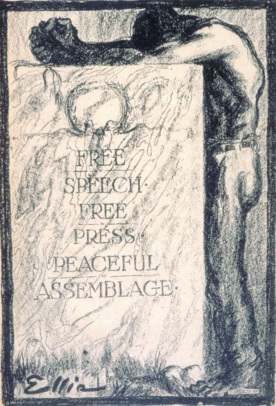
The next large-scale “threat” to American liberty in the eyes of the Americans of the late nineteenth century was the spread of Communism: a political/economic philosophy, based on the ideas of Karl Marx and Frederich Engels, which called for forced economic equality through violent revolution. 1 This potential forced cooperation was seen as a violation of liberty and the pursuit of happiness (read: property) which are both core American values. The forceful acquisition of private property alluded to in the Communist Manifesto would be a direct violation of several constitutional amendments which were put in place by the founding fathers because they saw private property as a part of what it meant to be independent. Therefore, with the rise of Communism, even one’s own neighbors can be seen as potential “overlords” who must be feared.
Meanwhile, in an example of both left and right sides of the political spectrum embracing nonconformity as an action of Liberty, many leftists who embraced Marxism at this time saw the bourgeois as current “overlords” and saw their participation in Communism as nonconformity against that culture. They saw themselves, just as the Confederacy did, as successors of George Washington and the American Revolution. However, with the Second World War on the horizon, both the left and right of American idealism would unite in fear of a new “overlord.”
WWII and the Rise of the Nazi Villain
While fears of Communism never really disappeared before WWII, The Second World War gave a new name and face to the hypothetical “overlords” which America fears so much: Nazis. Politically fascism embodies everything that both sides of the American spectrum seem to abhor. National Socialism, as a socially conservative form of Socialism, which is close to Marxism in its control over private property, represents an attack on Liberty from all angles. Even before the horrors of the Holocaust were known, the Nazis were still real-life villains who took away their citizen’s liberties and encouraged oppressive conformity. Even their marching was completely unified. If fascism came to America, the American way of life would disappear. As the Nazi threat became more real for Americans, in the events leading up to American entry in the war, Hollywood began to voice American anxieties over this particularly nasty new brand of “overlord.”
As I’ve highlighted in my article on X-Men and the Holocaust, Americans were widely unaware of the full extent of Nazi atrocities until much later in the twentieth century. Films that were made in Hollywood before and after America’s entry in WWII did not mention Nazi treatment of the Jews, but tried a different strategy for hitting the American nerve: Hitler’s destruction of Liberty. One of the ways films did this was by an emphasis on the forced conformity in Hitler’s regime.
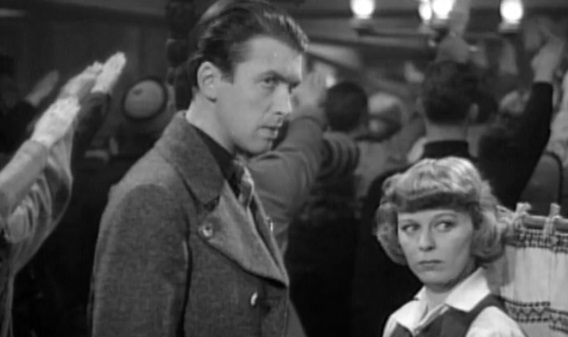
Warner Brothers was a studio which condemned fascism even before America entered the war. The Warners’ film Black Legion (1937) featured home-grown fascists and associated them with both the Nazis and the American Ku Klux Klan. In this way, the Warner Brothers were making a statement about white supremacist “overlords” at home who fear people who are different and don’t allow free thought within their ranks. This would have been considered a leftist call for nonconformity against the pervading culture of racism in America and Nazi Germany, and the thugs who perpetrate hate crimes. The trailer sells the film as “The story of a man, a woman, and a Mob,” implying that racism and hate crimes are the result of conformity to a mob mentality and highlights the two individual characters who do not conform to the status quo.
Another Hollywood film which was released before WWII, but spoke to American fears of “overlords” was MGM’s The Mortal Storm (1940) which explicitly dealt with the rise of Hitler. In a scene where it is announced that Hitler has won the Chancellery, the matriarch of the film’s protagonist family worries, “What about those who think differently? Freely? Those who are non-Aryan?” 2 This film speaks directly to the treatment of Jews and other nonconformists within Nazi Rule. One of the most poignant visual moments, seen in the screen capture below, shows the protagonists refusing to heil in a room full of Nazis; something that was very dangerous, but encouraged nonconformity.
A more conservative studio like the Walt Disney Company focused on the loss of individual freedoms in Nazi Germany in their wartime cartoons. In the cartoon short Der Fuehrer’s Face (1942), Donald Duck finds himself in a swastika-laden Nazi-land where he is forced to conform to Nazi ideals and work in a factory making shells. He is forced at the end of a bayonet to read Mein Kampf. In Reason and Emotion (1942) the studio shows audiences how Nazi ideology uses emotions to create mob-rule and those who use reason to question this ideology are put in concentration camps. Finally, in Education for Death (1943) the studio takes its audience through the life of a Nazi child named Hans as he is controlled from birth to be a robot-minded drone for the Nazi Party. The end of this cartoon short shows Hans as an adult marching in perfect conformity alongside his fellow Nazis while the narrator proclaims, “He sees no more than the party wants him to. Says nothing but what the Party wants him to say. And he does nothing but what the Party wants him to do.”
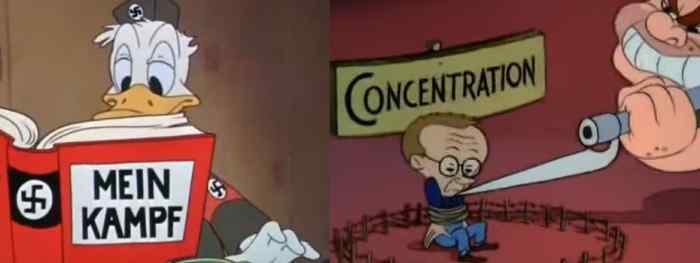
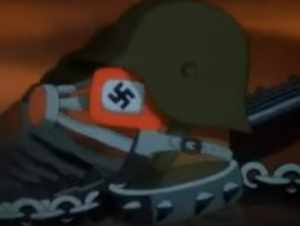
These heavy and dark themes may surprise those who think of the Walt Disney Company as mindless children’s entertainment. However, as this article will reveal, as events move closer to the present, Disney has been very ideological for a long time. WWII was the largest event of the 20th Century. It affected almost everyone in the country and was present in all forms of entertainment for children including comic books. Superman fought Nazis, and a new hero called Captain America was born to fight Nazis and famously punch Hitler in the face. Now that Disney owns Captain America and Star Wars, understanding these roots is key to placing The Force Awakens into its proper context further down the line.
Star Wars
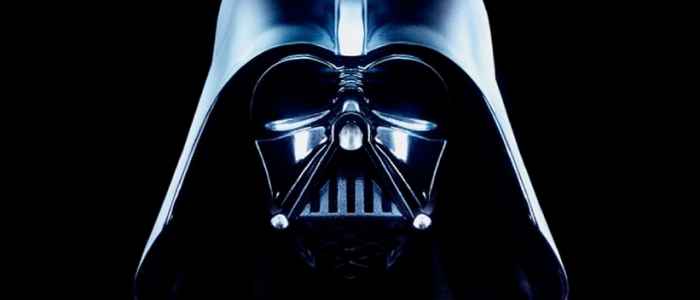
What happens, then, when your own country becomes, or starts to become the one thing Americans fear: their own version of “overlord?” This was something that a young George Lucas feared during the Nixon administration. When talking about the Emperor, Lucas said in 1981, “He was a politician. Richard M. Nixon was his name. He subverted the senate and finally took over and became an imperial guy and he was really evil. But he pretended to be a really nice guy.” 3 In 2005, Lucas explains that “It [Star Wars] was really about the Vietnam War, and that was the period where Nixon was trying to run for a [second] term, which got me to thinking historically about how do democracies get turned into dictatorships? Because the democracies aren’t overthrown; they’re given away.” If the Empire is supposed to represent America or a dangerous future for America, the use of Nazi aesthetics, such as the use of the name “Storm Trooper,” make a clear statement to the audience of the kind of black-and-white totalitarianism that could potentially lie in store. Understanding the meanings behind these Nazi associations and symbols helps to place Star Wars and other pieces of pop culture into context.
The Nazi Archetype in Popular Culture
What are some of the common attributes of Nazi or Nazi-like characters in American popular culture? The most common traits are as follows: Violently Authoritarian/Intimidation/ Power Hungry/ German (speaking with either a German or British accent)/ Narrow Minded/ Intolerant/ One Dimensional/ Unthinking/Mindless Drones.
Think about the villains we love to hate. How many of them have at least one of these attributes? How many have more or all of them? Here are a couple examples:

Whenever a villain is authoritarian there is a strong likelihood that a Nazi parallel will be drawn. The dictator Adam Sutler in the graphic novel V for Vendetta is a good example as are other “overlords” from other dystopian futuristic fiction such as President Snow from The Hunger Games. Both of these stories and their eventual movies use Nazi aesthetics such as color scheme (red, white, and black), symbols, and ritual to denote the connection. This article from The Artifice articulates the politics of The Hunger Games very well. In both these situations, a society slipped into this horror through politics or war, much like the Empire rose to power in Star Wars.
V for Vendetta was originally written as a critique of Margaret Thatcher and the film has removed a lot of the British nuances and was used as a metaphor for the Bush administration. However, in the wake of the Obama administration, many conservatives, especially libertarians, have embraced the story as their own proving the political transcendence of anti-fascism and the politics of resistance and nonconformity. Once again, both sides can potentially see themselves as victims or underdog heroes because both sides fear an authoritarian world so much. Things like surveillance, censorship, paternalism, or secret police forces are common threads used to maintain order and repress individual freedoms in stories with authoritarian “overlords.” 4 One of the more potent aspects of V for Vendetta in popular culture is the fact that the political activist/hacktivist group Anonymous has adopted the Guy Fawkes mask from the lead resister of the story as their symbol. This proves the emotional effectiveness of using the Nazi imagery in a film to encourage resistance.
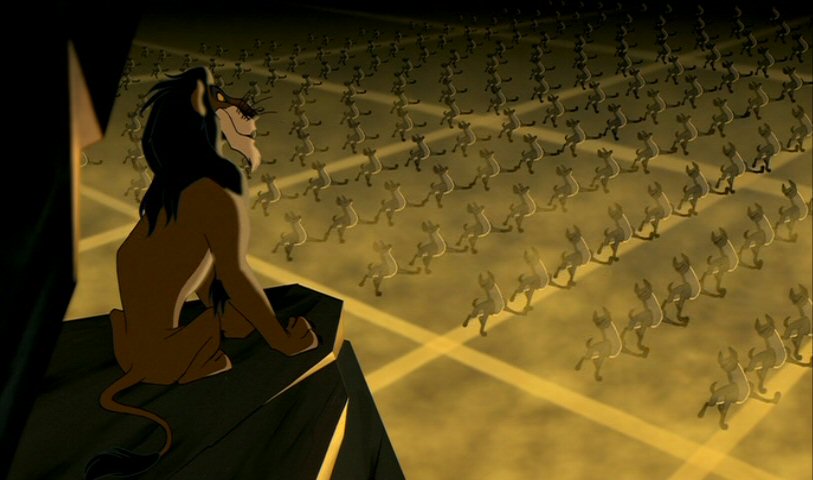
Some of the more interesting uses of Nazi imagery is when a piece of popular culture traces the rise of extremism and how totalitarian regimes emerge. V for Vendetta does this, but so does The Lion King, which traces Scar’s rise to power through the exploitation of the hyena’s hunger. This was a tactic that Hitler famously used: taking advantage of financial woes in the Weimar Republic and combined them with fear and frustration. What do the hyenas fear? Mufasa. Who does Scar promise to get rid of? Mufasa. The hyenas are frustrated that the lions have superiority and Scar gives the hyenas authority over them in the same way that Hitler promised to rid Germany of Jews and give Germans authority over the other countries and people they believed to be inferior.
Given Disney’s anti-Nazi history, it is not surprising that these themes would make their way into modern Disney films. For those who claim that Walt, himself, was a Nazi proponent or anti-Semite, this article would like to point to the fact that Walt was always anti-authority and pro-individualism. This was reflected in his propaganda films. With regard to his alleged Antisemitism, it is also important to remember that the heads of the Company during the Disney Renaissance were mostly Jewish. Michael Eisner (C.E.O.), Jeffrey Katzenberg (head of film division), Peter Schneider (head of animation, Alan Menken (composer), and Howard Ashman (producer and lyricist) are Jewish. Like the Warner Brothers, these men used Nazism to speak out against intolerance in our world. Movies like The Hunchback of Notre Dame feature this theme of racial intolerance explicitly and feature the gypsies as victims as they were also victims of Hitler. Other Disney films of this time which make these connections are Beauty and the Beast in which the mob song is reminiscent of Nazis marching with torches and singing about killing Jews (even reminiscent of the mob from Disney’s Education for Death).
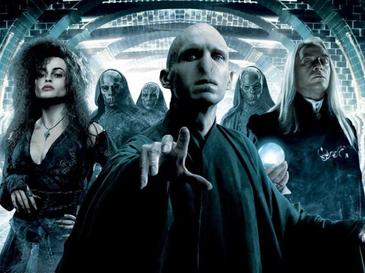
Disney is not the only company which, like the Warner Brothers during WWII used the Nazis as an example of extreme intolerance which should be avoided. Dream Works, for instance produced Chicken Run which parallels WWII, especially the Holocaust, in a world where chickens in a chicken farm face certain extermination at the hands of a chicken-pie making machine. The aesthetics of the farm are similar to a prisoner of war camp or concentration camp. How many chicken farms have you seen which have guard towers? Also, the older rooster. who served in the Royal Air Force, compares the owners of the farm to the “Jerries” a term used by British soldiers during WWII to describe the Nazis. In the film, the British chickens are saved by an American rooster who teaches them how to question and rebel against their given circumstances.
Perhaps one of the most present of these examples in popular culture in recent years is the Harry Potter series in which the villain Voldemort seeks to wipe out or enslave wizards who aren’t pure-blooded. These books, adapted by Warner Brother’s Studio, follow in a long tradition of creating totalitarian villains, but this case is special because it explicitly deals with a man who calls for genocide against several groups. This, along with Disney creates an education process for children in America and around the world. Children learn that racial intolerance is wrong and that people who march like the hyenas and carry torches singing about killing others are the bad guys.
The choice to cast Ralph Fiennes as Voldemort is also important because he had been so well known as the Nazi commandant Amon Goeth in the Holocaust film Schindler’s List. His portrayal of the sadistic war criminal points to another aspect of Nazi portrayal and Nazi-like villains which is important to understand: they are often portrayed as one-dimensional or even stereotypical. German accents, one liners (like “Ve have vays of making you talk”), senseless violence, or dismissal as being simply “insane” are some of the ways in which these villains are portrayed. While this is not always the case, when it is, it is because the “overlord” is not to be sympathized or humanized in any way. It is important to remember that real-life Nazis who committed atrocities were complex and sane individuals who made choices.
Often, there is a temptation to gloss over these facts, or even laugh at Nazis. TV shows like Hogan’s Heroes and Allo Allo, or even more serious films like The Great
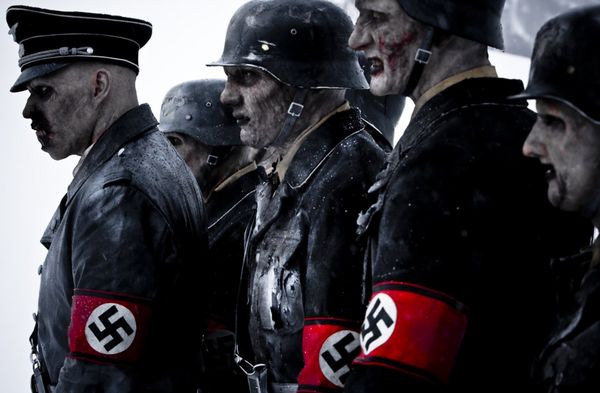
Escape or hilarious musicals like The Producers portray Nazis as mindless oafs. There is a potent political message in making fun of extremists because it deflates much of the power that they hold in their image. It shows them to be vulnerable and it embarrasses them. This is one of the reasons that Charlie Chaplin’s film The Great Dictator was so impactful in the 1940s. Portraying Nazis or Nazi-like characters as mindless, though, has a deeper meaning which is tied to conformity: the idea that conformists do not think for themselves. This idea is present in Star Wars in the fact that Storm Troopers are seen as so “weak minded” that they are susceptible to Jedi mind tricks. This idea is also represented in the Nazi Zombie phenomenon when one thinks of a “zombie” as something that is “mindless.” By this logic a Nazi Zombie can be read as: Nazi = Zombie.
There are many other examples in different mediums. Hydra from Captain America, Nazi villains in Indiana Jones, etc. The evil German doctor trope alone could fill many more paragraphs, but one thing is certain. Nazis represent the ultimate threat to American values even though their regime was defeated. In a way, it is the fact that they were defeated which makes them an ideal “overlord” because Americans know they they can be defeated.
The Force Awakens
For a company like the Walt Disney Company which encourages imagination and celebrates difference, conformity is a scary concept. Since Walt founded the company, Mickey has been battling authoritarian, power hungry, or mindless villains in his cartoon shorts. Even before Disney bought the rights to Star Wars, 1930s-’40s nostalgia was already a huge part of the culture of one of Walt Disney World’s theme parks: MGM (Hollywood Studios). This was an entire park which celebrated the power of film in teaching Americans how to think “outside the box” and imagine worlds past the confines of everyday monotony. A large part of the aesthetic and focus of the park is the Golden Age of Hollywood and the films from this era (many of which pertain to WWII). Animatronic versions of Humphrey Bogart give speeches about why we have to keep fighting (a la Casa Blanca) on the Great Movie Ride. Meanwhile, although not a Golden Age film, Indiana Jones fights Nazis from Raiders of the Lost Ark live about fifty feet away. Then about twenty feet over, guests can help fight the Evil Empire, themselves on the Star Tours, Star Wars attraction. There also used to be an exhibit on the Back-lot Tour dedicated to “Villains We Love to Hate” including Darth Vader and Amon Goeth. Why would the Happiest Place on Earth have an exhibit dedicated to villains? The answer is simple: because villains, especially Nazi-like villains, give Americans a clear sense of what we stand for by presenting them which what humans are supposed to stand against. This park gives the chance to witness these values in action whether it is Indy punching a Nazi in Cairo or a star-ship passenger vehicle somehow managing to out-fly and foil an Imperial plot.
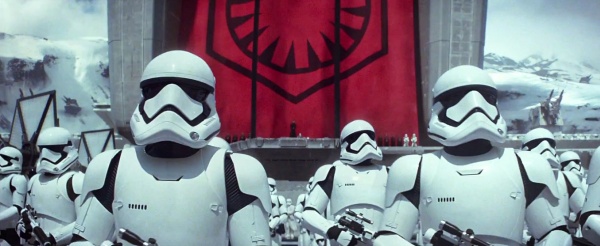
This is one of the reasons that it is so appropriate for Disney to own Star Wars. These values were seen in the new film The Force Awakens, particularly in the character Fin and the fact that he makes the choice to escape the First Order. The moment that he begins to think for himself, he is threatened with re-education and this superiors wonder when he first “started showing signs of nonconformity.” This would be an interesting discourse on nonconformity as it is, but the fact that the First Order is visually compared to the Third Reich through similar aesthetics to those listed above, raises the stakes of Fin’s newly found individuality.
Why make the Nazi connection to the First Order so explicit with a huge rally and Nazi-like banner before committing mass-genocide by wiping out an entire system? What is it about this new film which speaks to the world we live in, American values, and the new villains one must face? If the original Star Wars trilogy was about the optimism and self-righteousness of the Baby-boomer generation, The Force Awakens, reflects the ways in which Luke, Leia, and Han’s generation failed. Just as the young heroes of The Return of the Jedi were unable to completely wipe out the “overlord” ideology of The Empire, the hippies of the 1960s and ’70s turned into the yuppies of the 1980s and ’90s. In a post-9/11 world, there are many, especially young people, who grew to distrust the government and their seemingly authoritarian methods in the name of “safety.” In The Force Awakens, there are also allusions to the dangers of “regime changes” which echo the way in which the War in Iraq is believed to have created ISIS, a newer, more powerful villain like the First Order.
However, these negative reflections on the Baby-boomer generation as having become the creators of the modern “overlords” is not a rejection of the optimism and ideology present in the original Star Wars trilogy. Rather it is a reminder, in this time of shifting national identity, of those American values which were once held near and dear and are needed again now: individualism, innovation, nonconformity, and bravery. It reminds Americans that even larger, better equipped versions of our past enemies can be defeated. When Rey desperately holds out Luke’s lightsaber to an older, sadder, tired Luke, she is speaking on behalf of the younger generation saying “We still need you.” We need your courage, your optimism, your uniqueness, and even your recklessness. The force is awake. Will you take the call?
Works Cited
- The Communist Manifesto written by Marx and Engels calls for a violent overthrow of the bourgeoisie by the proletariat (the working classes) and the acquisition of all private property to come under control of a centralized proletariat state. “In depicting the most general phases of the development of the proletariat, we traced the more or less veiled civil war, raging within existing society, up to the point where that war breaks out into open revolution, and where the violent overthrow of the bourgeoisie lays the foundation for the sway of the proletariat.” (Marx, 20). While subsequent pamphlets and writings by these men say that a non-violent acquisition of private property would be ideal, they justify the eventual violence of the proletariat on the grounds that the proletariat has been the victim of bourgeois violence for centuries. “It would be desirable if this could happen, and the communists would certainly be the last to oppose it… But they also see that the development of the proletariat in nearly all civilized countries has been violently suppressed, and that in this way the opponents of communism have been working toward a revolution with all their strength. If the oppressed proletariat is finally driven to revolution, then we communists will defend the interests of the proletarians with deeds as we now defend them with words.” (The Principles of Communism, Engles, 48) While there are many modern day men and women who consider themselves “Marxists” who claim that the violence of Communism was never intended, it is undeniable that violence has always been a key component of Marxism. The purpose of the inclusion of this fact is not to refute Marxism, but to explain why many Americans felt threatened by Communism long before the Soviet Union existed. ↩
- The reference to this film and Black Legion comes from the documentary Imaginary Witness: Hollywood and the Holocaust (2004) ↩
- Rinzler, J.W.. “The Making of Star Wars: Return of the Jedi.” New York: Del Rey Publishing. 2013. ↩
- Jenkins, Lee. “How Both Left & Right Claim V For Vendetta As Their Own.” The Backbencher. Oct 31, 2013. Web. Jan 7, 2016. ↩
What do you think? Leave a comment.











The Nazis are everyone’s bad guys: the West’s, the Russians’, the Jews’ (obviously), even the Germans’ themselves. You can insult the Nazis without offending anyone.
Fascism 2015: good.
Third Reich fascism: bad.
I wonder how much of our obsession with the Nazis comes from the simple fact that the immediate post-war period saw the spread of accessible media, particularly the television…. and that so much of what we were seeing was informed by the war, either directly with the slew of war films that were produced, or indirectly in that the people making this stuff were personally affected in some way by the experience of the war. It’s commonplace now, of course, but was this the first war to be covered in such detail in popular media?
I was born in the 1970s (closer to the end of the war than we are now from my birth) and I grew up watching films like The Great Escape, Damn Busters, Where Eagles Dare and so on, right down to television fluff like ‘Allo ‘Allo…. and the Nazis in many of those films are compelling and essential villains (yes, in great uniforms). Other than cowboy films and their portrayal of the Native American, what other bogeyman has been so extensively covered?
And, of course, this kind of history was written by the winners. You watch those films, and you know that we fought and won a “just” war (with the odd honourable exception like “Cross of Iron” that tried to show a more nuanced version of the war)
Not long ago I read a pretty good (factual) book about the aftermath of WWII and how some members of the Nazi hierarchy escaped justice/hid out in South America. The author (Guy Walter, I think) talked in an interesting way about hay Nazism had a “cultural moment”in the 70’s. Movies and books like Boys from Brazil, Odessa File, Marathon Man, The Night Porter, The Eagle Has Landed, tv shows like Secret Army, Colditz I’m not sure what all this meant, apart from the fact there was a significant public appetite for this entertainment.
The events of WWII had a huge impact on Britain, as they did on many other countries. WWII saw the USA overtake Britain as the world’s dominant power and the aftermath saw Britain relinquish most of its empire.
Some of those more personally affected are still alive today. When a local hospital installed a new siren to signal major emergencies, we had to ask them to change it as my 85 year old mother still shits herself when she hears an air raid style siren. That sound takes her straight back to 1941 and she becomes a scared 10 year old girl, cowering under a table under the stairs and then being dug out of the rubble of her home by neighbours.
When you were born in the 1970s, there were two fascist governments in Europe: the Generals in Greece and Franco’s government in Spain. The latter had survived since before WWII. Now we have far right groups in Ukraine who participated in the shootings on Maidan, have had ministerial roles in the interim government and who are fighting in Donbass, using the same battalion names used by the grandparents, fighting for the Nazis in WWII. In the last week, they also attempted to storm the president’s office, with talk of a third Maidan. The ripples of WWII continue to impact people in Europe today.
“Nazism had a “cultural moment”in the 70’s. Movies and books like Boys from Brazil, Odessa File, Marathon Man, The Night Porter, The Eagle Has Landed, tv shows like Secret Army, Colditz I’m not sure what all this meant, apart from the fact there was a significant public appetite for this entertainment.”
Indeed – I grew up in that era and I absolutely lapped up anything to do with WW2. One of my most prized possessions around the age of 11-12 was the “Escape from Colditz” board game, which my mates and I played incessantly. The game and its components were liberally sprinkled with Nazi insignia and my mother later confided that she really wasn’t happy about my obsession with it: having grown up during WW2 she regarded the Nazis as the epitome of evil and said that she literally felt a bit queasy any time she saw a swastika.
This is a very interesting article. I agreed with everything. I’d be interested to read a follow-up to see what you think when the next star wars film is out.
The Force has always been at least implied to be hereditary. Even in the first film when we didn’t know Vader was Luke’s father we knew that *Anakin* was his father, and had been a great Jedi Knight.
Great article, not sure if it all holds water or not but well reasoned.
I guess I’ll take that. I’d be interested in knowing what parts you thing don’t hold water.
Lucas broke Star Wars by changing the Force – from a power achieved through self-mastery, into a genetically conferred superiority complex. Then he went on to wreck our memories of the original film.
I disagree, I think he enhanced the force with the introduction of midi-chlorians. (a very unpopular opinion I know but hey- nonconformity and all that :D)
Interesting. I’m not sure if all this can stand, I’m not even surprised to know Disney did such cartoons. Their film Pinocchio preached nonconformity in some ways too, in the end, nonconformity doesn’t always equal anti-Nazism. Sometimes it does and sometimes it doesn’t. But in the end, interesting and very thoughtful analysis.
Hmm. I think you may have read into my argument backwards. Nonconformity doesn’t always equal anti-Nazism but anti-Nazism often (not always but often) equals nonconformity. : )
That’s just the thing. I disagree. I know loads and loads of anti-Nazis and they always conform to one standard or another. That’s the whole thing about peer pressure, really, and the desire to conform to society and to the wider culture as a whole. Don’t get me wrong, I think your article is well written and I find the Nazi trope in fiction very interesting, but I disagree with the message of conformity.
Well youre talking about real people. I’m talking about the way that anti-Nazism is portrayed in film.
Christen your article is full, very dynamic. There are many jumping off points where you can go into deeper conversations. I would like to dive into two pools. First, reanimation of marginalization; we see this take place in many forms and throughout many generations and cultures. The reanimation of marginalization (Gay, Black, Muslim, Women, and indigenous peoples, Zombies or Nazis) of the ‘other’ carries conflict and continues the unfounded fears without resolution. So while one group conforms to their ideologies they are exclusive in their membership unfortunately this type of popular human behavior can be found globally.
The second river of thought regards the zombie. A zombie; a reanimated corpse appears to be a global phenomena. Most of the American, African, Caribbean, British and various indigenous people have zombies that are unhurried and move with the masses. They exist to meet their baser needs; similar to a number of societies members who are passive, inert, awake half, numb to existence when going to work or school. However, these members will participate in mob mentality all which is reflective of conformity.
Conversely, I have to say that the zombie portrayal in Dead Snow is quite the opposite of our less than cerebral common zombie. These Nazi zombies are a group that the ‘others’ most definitely have a legitimate fear. They are not the zombies of TWD or Shaun of the Dead. They are ‘Superior’ Nazi Zombies that will stop at nothing to win their war. Firstly, they are uniformed quite nicely I must say. Secondly, they are highly militarized in their organization, communication, weaponry and agility. The Zombie Nazis are participating in exclusion to maintain their conformity.
Dead Snow Zombie Nazis Rock!
Thank you for your feedback. Of course, there are many ways in which the article could be expanded but I always like to keep them around a certain length so there are things which I don’t always get to go as deep in as others.
I touch on marginalization in this article especially with regard to foreigners in this country and how Disney and Warner Bros. especially use the Nazi motif to address issues of otherness and difference in American culture.
Secondly the zombie phenomenon in world culture has been interpreted to mean many different things. I do not claim to hold the key to the genre, just another way of looking at it. Thank you for your feedback.
Great analysis. The different examples you brought in really support the article. I find it interesting how the media portrays the villains in ways similar to the Nazi aesthetic, thus presenting to the audience that they should be against such movements in real life. Is pop culture convincing us to conform to this nonconformity? Ah-ha~
The Nazis are people’s favourite baddies. They seem to epitomise everything bad. Especially in films. As soon as you see an iron cross, swastika or golden eagle you know who the villains are without too much time wasted, this moves the plot forward with ease. If a Nazi gets killed in an elaborate death there is never any sympathy. We are always going to be behind a hero who defeats who we regard as the worst people ever.
Villains in other films are based upon the Nazis such as the Imperial Empire in Starwars. They have their storm-troopers and commanders coal scuttle helmets and clicking big boots. They are more than a passing nod to the Nazis.
The Nazis in the Indiana Jones films are ridiculous pantomime villains. They don’t need much character development. Everyone knows what the Nazis are about and can guarantee evil shenanigans.
They make us feel good about ourselves. They were this ‘absolute evil’ that we had a decisive part in destroying. And in doing so, allowed us to conveniently ‘forget’ each and every of our misdeeds prior to that.
Yes I entirely agree with this. We have this recent historical story where we overcome the evil of the Nazis in WWII and we use that story to erase stories prior to that where our society was guilty of genocide.
A great commentary on some average work.
It is a plain fact that sci-fi is more about the present than the future, and anyone who can think knows that there are useful readings to be had from relating sci-fi narrative to its cultural context. However, I’m not sure that the Star Wars narrative is sufficiently subtle to yield up much of real value.
To be honest for all the Empire was portrayed as being evil they seemed to do very little in the way of oppression.
Everybody seemed perfectly happy until Leia started causing trouble.
Great links between sci-fi movie and contemporary politics.
Similar echoes are present in the Hunger Games latest movie..
Yes, I believe I mention the Hunger Games. I wish I could have gone into more detail but there are several articles on here about that series and the politics contained therein.
Well crafted and extensive article including insights on relationships between creation, history, and culture.
I never knew Lucas created a discourse with the OT about the Vietnam War and Nixon. His quotes and your analysis have actually made me appreciate the Prequels a little bit more. Well Palpatines arc, at least…
Very nice article!
The main stream media and Hollywood are obsessed with what happened in Germany a long time ago. Worse things have happened before and since, time to get over it.
Well, it’s not just about what happened in Germany. WWII was a world war, meaning that it affected most of the world. It was the single most traumatic event in the 20th Century for most people.
No, it WAS the most important event in the 20th century. Period. No need to slip into relativism.
Though the First World War was close: it lead to increased nationalism, fascism, the carving up of the Middle East, and introduced to the battlefield radio communications, airplanes, bombing, poison gas (more or less), the tank, machine guns (on a mass scale, though they were there in the Boer War too), and the use of trucks and the railway to move masses of troops.
The “get over it” comment is just anonymous trollish silliness. Those who forget history are condemned to repeat it. I think that historical ignorance often comes from people who are too lazy to learn a few facts. And from the fact that we live in a highly narcissistic society where people tend to disparage things that don’t directly affect their egos.
“Get over it?” Really? Tell that to the families of the victims. Unless we remember and continue to tell the truth of the atrocities of the Nazis, history will repeat itself, because as many here have said, we all have the potential to be “Nazis” under the right circumstances. The lessons of man’s cruelty to his fellow man taught to us by this horrible time in our history must not be forgotten, lest we believe it was normal behavior and are then destined to repeat it. There is a great rise in Neo-Nazism throughout Europe at this time. This is not the time to “get over it.”
It’s within living memory not a long time ago. Have worse things happened since? I don’t wish to turn this into a competition but what things? As terrible as it was, I don’t think the genocide in Rwanda was as extensive or brutal but I wonder if more Rwandans had understood the lessons of the Holocaust, perhaps fewer would have been as willing to carry it out.
It’s far from time to ‘get over it’.
Dang. Like the author point out, it was a long time ago, but being a World War, its ramifications are still being felt today and thus, not time to get over it.
Zombie Nazis are always a hit.
If you want the entire politics of the SW saga explained, watch the entire “The Clone Wars” animated series where it is all laid out – along with the mysteries of “The Force” that are not answered in the movies.
I have seen the entire Clone Wars series and interestingly enough the first episode speaks to individuality and non-conformity when Yoda talks to each clone and points out their differences.
An interesting applicability.
No surprise that the “folks” who run Hollywood are keen on “Nazi” imagery.
Is that a Jewish remark?… Because that article already talks about that but as a fact and not in a derogatory way. I hope you are not implying something anti-Semitic
An excellent piece, certainly one of the finest pieces I’ve read in this publication for some considerable time.
Thank you very much!
The politics is pure genius!
In A New Hope, Governor Tarkin appears to be the ultimate Nazi – callously destroying Leia’s planet, presumably home to billions of beings, without a second thought, just to make a point. He doesn’t even consider sending an evacuation warning to Imperial staff at Alderann’s Galactic Embassy, he’s that bad.
Lucas used Nazi/Wehrmacht inspiration in the original trilogy folks. The stormtroopers were actually WW I German assault troops then the name for the Brownshirts of the Nazi SA. Those imperial uniforms looked like they definitely had Wehrmacht inspiration. The TIE Fighter roar was inspired by the Stuka siren according to an interview with Lucas a long, long, time ago…..
Interesting, thoughtful piece.
I always though the Empire of the first film was quite a lot how I imagined the British Empire was, a sort of bunch of dull bureaucrats who ruled the wold via a mix of efficiency and entitlement. And were all British for some reason.
I thought it was quite an interesting article.
To be honest, I wish they would have made The Force Awakens less “black & white”.
But then again, there is always an agenda coming from hollywood (the good forces of multiculturalism vs. the evil fascist Empire).
This is what I always hated about the prequels too: Its never really explained how seductive and possibly even right the dark force was: Instead they just turn into evil any character that falls to the dark side, or portray them as delusional (Anakin Skywalker).
They could really make starwars films with a fine line defining what is light side and what is dark, but then it wouldnt be a film for 12 year olds I guess.
Another wonderful and insightful article. One comment I would like to make is that there is a very thin and blurry line between “freedom” and “nonconformity” in American cultural values and also politics. In such categories, not everyone is included and entitled to this freedom, although the Bill of Rights or Constitution states this. I think the fear and anxiety of losing freedom has increased, because there is often a struggle on who should be entitled to “freedom” without undermining American nationalism.
The parallel of “the rise of the Third Reich” and “the rise of the Empire” is certainly present, I remember watching a TV special where Lucas described this as his original intent. The Empire’s uniforms also clearly emphasize the theme of oppression. Not to mention how those films (and Lucas films in general) have always tried to express american values. Deep article!
Incredible article. It never really occurred to me that there was this deep a connection, but after reading this, I feel like my eyes have been opened. Excellent work!
Interesting article – the Nazi imagery in Star Wars is pretty obvious, though I always thought (which you hint at) that a major ideological theme of at least the original theory was the founding American myth of the good rebels of the Revolution fighting the evil British overlords, though subsequent history made this myth just that – a myth. I’m thinking of the attempt to conquer Canada in the War of 1812, the Civil War, the conquest of the West during the Indian Wars of the 19th century, the presence of slavery in the US as late as 1865 even though the supposedly Evil (British) Empire outlawed the slave trade in 1817, etc.
You can really see this myth at work in other works of American pop culture – in the terrible film The Patriot, in the much better though ideologically muddled TV series Sleepy Hollow, in the many Hollywood films where British actors play straw-men villains while out-acting their American counterparts (e.g. Die Hard), or where British actors play comical sidekicks (with a tip of the hat to Hugh Grant).
So I think the original Star Wars is a mixture of anti-Nazism on the surface, Lucas’s resentment toward Nixon and the legacy of Vietnam, and the founding American myth of the good rebel fighting the evil empire. The resurrection of Peter Cushing, along with the casting of the other Imperial leaders, in Rogue One seems to clinch this.
Interesting article – the Nazi imagery in Star Wars is pretty obvious, though I always thought (which you hint at) that a major ideological theme of at least the original trilogy was the founding American myth of the good rebels of the Revolution fighting the evil British overlords, though subsequent history made this myth just that – a myth. I’m thinking of the attempt to conquer Canada in the War of 1812, the Civil War, the conquest of the West during the Indian Wars of the 19th century, the presence of slavery in the US as late as 1865 even though the supposedly Evil (British) Empire outlawed the slave trade in 1817, etc.
You can really see this myth at work in other works of American pop culture – in the terrible film The Patriot, in the much better though ideologically muddled TV series Sleepy Hollow, in the many Hollywood films where British actors play straw-men villains while out-acting their American counterparts (e.g. Die Hard), or where British actors play comical sidekicks (with a tip of the hat to Hugh Grant).
So I think the original Star Wars is a mixture of anti-Nazism on the surface, Lucas’s resentment toward Nixon and the legacy of Vietnam, and the founding American myth of the good rebel fighting the evil empire. The resurrection of Peter Cushing, along with the casting of the other Imperial leaders, in Rogue One seems to clinch this.
[dear editors: cut the previous version of this comment]
This is an interesting piece of writing. One of the challenges that we face as a culture is how to digest the messaging of a piece of entertainment/art, coupled with the difficulty of parsing the role of the messenger in the ultimate impact of the message. In the case of Disney (particularly late-period, multimedia conglomerate Disney), there is certainly a corporate drive to be a pinnacle hegemon in the entertainment world, but in pursuing said goal, they have been careful to emphasize messaging that plays into our American self-mythologizing ideals of “freedom” and (to an extent) nonconformity as desirable ideals. However, even reading into the Star Wars universe separate from Disney, we can begin to see difficulties with this narrative. We are rooting for the Rebellion, and rebellion certainly aligns with nonconformity in the American lexicon, but of course, once you join up with the Rebels, you begin to be homogenized as part of a uniformed fighting force. The Rebels aren’t as homogenized as Storm Troopers, but they are still uniformed combatants. There is a suggestive thread of nonviolence in the series (don’t give in to your hatred), which is a deeply nonconformist value in our society, but this is contrasted with a theme of powerful violence as an answer to problems. Yoda, for example (a character who is as close in the original trilogy to a Zen master as any character in a major American entertainment), is shown as lightsaber master in the prequels who must fight his way out of a bind (not use nonviolent resistance or Jedi mind tricks). After all, the title of the series is not Star Diplomacy, but Star Wars.
I am reminded of Calvin (of Calvin & Hobbes), when he discovered that mainstream commercial nihilism can’t be trusted.
https://neonhero.wordpress.com/2010/06/06/mainstream-commercial-nihilism-cant-be-trusted/
It is one thing to produce the Force Awakens (which, full disclosure, I thoroughly enjoyed), and seem to emphasize freedom and a version of nonconformity, it is quite another to ensure that as an entertainment enterprise, the saturation point of that message is so high that to nonconform (by, say, not participating in the cultural phenomenon that is Star Wars) is unusual and discouraged. How nonconformist can a mass-market entertainment message truly be, in other words? I was born 1 year after New Hope (or “Star Wars” as people my age will forever call it), and the messaging in those films did serve for my child-self to emphasize the value of doing what is right, approaching the world with empathy, serving freedom, pursuing moral rectitude, and so on. How much of this emphasis that I took was due to my age when I was first exposed to those stories? If I experienced them as a full grown adult for the first time, aware of the marketing machine behind the enterprise, would the message have meant the same thing to me? Hard to say. I think Lucas’ rooting the stories in the global mythological tropes identified by Joseph Campbell went a long way to insuring that they spoke to ideas beyond their commercial circumstances, but I also can’t pretend that this isn’t a capitalist product designed (especially at this historical moment) to make buckets of money.
At any rate, thanks for an interesting read. Lots to dissect here.
What an interesting connection that you have established here between Nazi Germany and the pop-culture of films past and present. I do think it is true that every generation has a different way of thinking about how to resolve issues affecting our way of life. Whatever comes about is unknown to many of us for we can only hope for the best and expect the worst in times of distress.
This is a pretty illuminating piece. I appreciate the broad span of history you cover as well as the subtle connections you pick up on between Nazism and pop culture portrayals. Nice job!
I always knew that Star Wars projected Nazi themes into their villainy, but I never thought about how much Disney as a whole did into pop culture. I think its absolutely fascinating how America has a kind of paranoia regarding its liberty and the way pop culture manipulates this mass anxiety as a way to uphold this principle. Well done!
A good essay. Showing how the Second World War and Nazi themes weave through films is interesting and insightful.
I think that Fin breaking out of the Stormtrooper mold in The Force Awakens is reflective of a Post-Modern sentiment coursing through North-America’s veins as we speak. With the fear of overlords and movement towards non-conformity, I’d like to touch on the point of Communism. Even though many felt they were breaking the mold and doing the non-conformity thing by becoming Communist, it was the conformity to fear of Communist overlords and rules that caused much of the destruction echoing still from the 20th century.
With a return to these ideas felt through Post-Modernism, I’m asking myself not how Star Wars could relate to this even further. Perhaps Darth Vader, when he kills Sidius and saves Luke, both breaks the Sith mold and conforms to the prophecy he was slotted into as a child – the prophecy which weighed on him in such a way that it tipped him towards the dark side.
Overall I think that this article touches on an interesting strain of Western thought, but I’ll still think of the new movies as a curse from the Dark Side.
Insightful analysis of American values and of Star Wars. It could be said that the Amish are not practicing non-conformity, but just conforming to a non-mainstream group, but a counter-point to this could be that the hippies aren’t really embracing individualism either, but just conforming to their group.
I don’t understand how allegations that Walt Disney himself was anti-Semitic are refuted by the fact that Disney had Jewish leaders in the 80s and 90s, after he was dead.
The Star Wars Storm Troopers look similar to the SS because they were the direct model (SS is the acronym for the German, “Schutzstaffel”, which literally translates to Protection Staff, which is the role that they serve in Star Wars). There is also some foreshadowing in the form of Darth Vader (another German phrase, literally Dark Father, which serves as an allusion to a darker past).
Just food for thought!